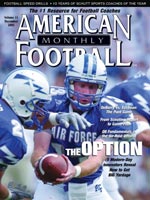AMERICAN FOOTBALL MONTHLY THE #1 RESOURCE FOR FOOTBALL COACHES
Article CategoriesAFM Magazine
|
Pattern ReadingUnderstanding Vertical and Horizontal Stretchby: Mark Miller Secondary Coach © More from this issue This article is part two of a two part series. Part one was entitled: Landmarks: The Foundation of Zone Coverage. Pattern Reading serves three purposes for the defense. Defenses utilize a system of ‘Pattern Reading’ to get an early indicator of what type routes the offense is going to execute. It also serves to reduce the number of possible route combinations that the defense must anticipate and defend. Thus, maximizing the efficiency of how we leverage routes in zone pass coverage. Stretch Principle
Subscribe today!
|
|
||||||||
| HOME |
MAGAZINE |
SUBSCRIBE | ONLINE COLUMNISTS | COACHING VIDEOS |
Copyright 2025, AmericanFootballMonthly.com
All Rights Reserved






